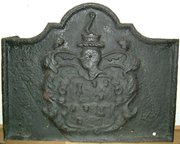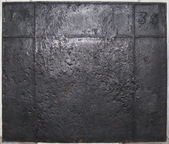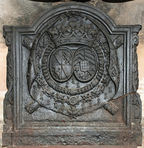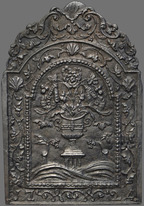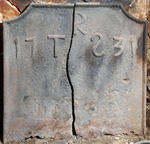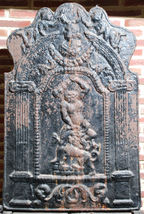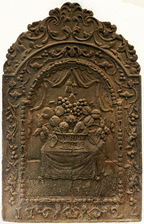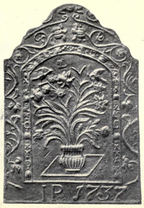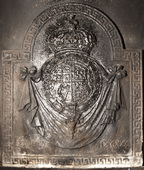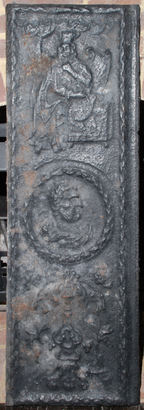-
16
Description: Arched rectangular shape cut away with symmetrical concave curves; ovolo moulding (top and sides); shield, helmet, crest and mantling of the family of Baker, of Mayfield, quartered with Farnden, of Sedlescombe: Quarterly, 1st and 4th, Argent, a tower between three keys erect sable (Baker); 2nd and 3rd, Purpure, a chevron vairy Or and gules, between three leopards’ faces Or (Farnden). Crest (Baker): on a tower sable an arm embowed in mail holding in the hand a flint-stone proper.
Notes: A carved armorial on a plain, edged base board; John Baker (1644-1723) married Ruth, daughter and co-heiress of Peter Farnden, in 1663; she died in 1691, thereafter the arms of Baker quartered those of Farnden; the arms of Farnden had been granted in 1634. The armorial design has been inadequately pressed into the sand bed.
Copies of this fireback are known.
Arms: Baker, of Mayfield, quartering Farnden, of Sedlescombe
- Decoration tags:
- rectangular with canted top corners and round arch (shape)
- ovolo (edging)
- carved pattern panels
- armorial
Manufactured: in the early- to mid-18th century possibly at Heathfield Furnace in the Weald area of England.
Current location: Battle Museum of Local History, Battle, East Sussex, England.
- Attached to series:
- Personal armorial firebacks
- Ironmasters armorial series
-
203
Description: Rectangular; fillet edging; fillet parallel to top edge separating top quarter; two fillets parallel to sides separating side quarters; halves of date in top corner squares.
Notes: Numeral style is typical of first half of 18th century.
Inscription: 17 36
- Decoration tags:
- rectangular (shape)
- fillet (edging)
- individual numbers
- text
Manufactured: in 1736 in England.
Current location: Selly Manor, Birmingham, West Midlands, England.
(part of the Selly Manor museum group)
- Attached to series:
- Date only firebacks
-
957
Description: Upon a rectangular base plinth, an arched rectangular, ovolo-moulded panel containing a draped cloth (disclosing on the reverse the arms of Duras) upon which two oval shields are surmounted by a ducal coronet, and encircled by the collars of the Orders of St Michel and Saint-Esprit. Behind the cloth are crossed batons of a Marshal of France; on each side are flattened S-scrolls with tassels.
Notes: In all probability the arms of Jean-Baptiste de Durfort, Duc de Duras (1684-1770), created Marshal of France in 1741.
Arms: Durfort, duc de Duras
- Decoration tags:
- rectangular with round arch (shape)
- ovolo (edging)
- whole carved pattern
- armorial
Manufactured: in the early- to mid-18th century in France.
Current location: Chateau de Duras, Duras, Lot-et-Garonne, France.
- Attached to series:
- Foreign armorial firebacks
-
1032
Description: Arched rectangular shaped central panel with solid and hollow bead on fillet edging, grouped alternately in threes and twos respectively, on a wide fillet; on a Tuscan pedestal rising from waves, a narrow waisted, gadrooned flower vase with two scrolled handles and a horizontal banded decoration from which issue tendrils bearing flowers, berries and seed pods; arched rectangular shaped border with fillet edging, wide at the sides, symmetrical floral fronds descending from a scallop shell, top centre, with a scallop shell inside each shoulder; at base, date split between two looped 'W' figures; on top, symmetrical scrolled plant tendrils descending from a central scallop shell.
Notes: The third largest of six flower vase firebacks designed and made in the same year, larger ones of which include a religious inscription in Welsh. All incorporate the looped 'W' motif which may be intended to identify the pattern maker. Cheffins auction, Cambridge, 13 Jun 2018, lot 738 (£240).
Copies of this fireback are known.
Inscription: 17 24
Manufactured: in 1724 in England.
Current location: not known.
- Attached to series:
- 1724 series
- British 'Dutch' style firebacks
-
969
Description: Cavetto-canted rectangular shape; astragal edging (top and sides); letters in triad between separated date.
Notes: The modest size of this fireback reflects the decreasing size of fireplaces in the 18th century.
Inscription: 17 TRS [triad] 31
- Decoration tags:
- rectangular with canted top corners (shape)
- astragal (edging)
- individual letters
- individual numbers
- text
Manufactured: in 1731 in the Weald area of England.
Current location: in private hands, Cowden, Kent, England.
- Attached to series:
- Date & initials firebacks
-
46
Description: Ionic columns supporting a semi-circular arch, in the centre of which the bust of a man has a floral swag beneath; below is a quasi-arched rectangle of beads within which is the figure of Hercules, wielding a club, slaying the Nemean Lion; beneath are floral scrolls; on top of the main arch two kneeling putti hold a wreath over the bust.
Notes: Not the standard 'Dutch' type, which may indicate a different origin. Copies of this fireback were advertised in Burton Weir's (Rotherham) catalogue in the early-20th century.
Copies of this fireback are known.
- Decoration tags:
- 'Dutch' (shape)
- fillet (edging)
- whole carved pattern
- pictorial
- mythological
- animals
- humans
- objects
Manufactured: in the early- to mid-18th century in England.
Current location: in private hands, Cuckfield, West Sussex, England.
- Attached to series:
- Late pictorial series (all)
- Late pictorial series 6
-
1301
Description: Arched rectangular shaped central panel, bead-and-pellet on fillet edging; beneath swagged curtains, a basket containing a variety of fruit - plums, apples, pears and grapes - resting on a table draped with a fringed cloth; arched rectangular shaped border with fillet edging and symmetrical foliate tendrils; date in bottom corners split betwen foliate tendrils incorporating looped 'W' shapes; on top, symmetrical scrolled plant tendrils.
Notes: One of a series of firebacks made originally in 1724. The basket of fruit was probably inspired by still-life paintings by European artists of the first half of the 17th century. Formerly at Salem, Massachusetts.
Copies of this fireback are known.
Inscription: 17 24
Manufactured: in 1724 in England.
Current location: Historic Deerfield, 80 Old Main Street, Deerfield, Massachusetts, United States of America.
Museum number: HD 53.086 (part of the Historic Deerfield museum group)
- Attached to series:
- 1724 series
- British 'Dutch' style firebacks
- Fruit basket firebacks
-
869
Description: Low arched central panel with fillet edging; on a square frame in perspective, a small gadrooned pot with flowers, including daffodils and tulips, issuing from it; narrow fillet border of same shape, around top and sides, containing a repeated chain and tassel design; wide outer border with quasi-symmetrical, wave-shaped top, swirled floral design of hare bells and tendrils; inscription at bottom.
Notes: In the museum guide of 1912, this fireback was said to have come out of an old house at Arran Quay, Dublin.
Inscription: IP 1737
Manufactured: in 1737 in Ireland.
Current location: National Museum of Ireland, Benurb Street, Dublin, Dublin, Ireland.
Museum number: NMIDM:1910.564 (part of the National Museum of Ireland museum group)
- Attached to series:
- British 'Dutch' style firebacks
-
1292
Description: Arched rectangular shape; Greek Key border with fillet edges; in high relief, in front of swagged drapery, the shield of, quarterly, France quartering England, Scotland and Ireland, surrounded by a Garter, and surmounted by a ducal coronet; below, the inscription in capitals.
Notes: The use of the Greek Key design as a border is believed to be unique for an English fireback. Although somewhat indistinct, the use of the Stuart royal arms and the ducal coronet can be explained by the fact that the fireback was one of a group cast for the 2nd Duke of Richmond, whose father, the 1st duke, was the illegitimate son of Charles II and Louise de Kéroualle. The Richmond arms were differenced from the Stuart royal arms by the addition of a bordure compony (the detail of which is not distinct on this casting). Sowley Furnace, near Beaulieu in Hampshire, was owned in 1732 by John, 2nd Duke of Montagu, and was let to Miles Troughton. An identical fireback also at Goodwood is dated 1731 and a similar, but smaller, variant of this fireback, is dated 1732.
Copies of this fireback are known.
Inscription: HONI SOIT QUI MAL Y PENSE / SOWLEY MDCCXXX
Arms: Duke of Richmond
- Decoration tags:
- rectangular with round arch (shape)
- fillet (edging)
- whole carved pattern
- heraldic
- armorial
- royal
- text
Manufactured: in 1730 at Sowley Furnace, Beaulieu in the New Forest area of England.
Current location: Goodwood House, Westhampnett, West Sussex, England.
-
923
Description: Rectangular; overlapping laurel leaf edging with flange on right edge; top, seated figure of a monarch with a casket at his left side and the back of a throne behind; centre, bust of a classical male figure facing to the right, surrounded by a circlet of overlapping laurel leaves; bottom, ornamental pedestal on a legged stand, floral fronds issuing from the top, between two flower heads, and descending symmetrically to the bottom.
Notes: Not a fireback, but a left side fireplace back plate. It had a circular aperture in the centre into which, in this instance, a medallion and bust were inserted, the same being inserted into an elaborate baroque fireback (no. 452).
- Decoration tags:
- rectangular (shape)
- overlapping laurel leaf (edging)
- carved stamps
- carved pattern panels
- biblical
- humans
- plants
Manufactured: in the early- to mid-18th century probably at Robertsbridge Furnace, Salehurst in the Weald area of England.
Current location: in private hands, Heathfield, East Sussex, England.
- Attached to series:
- Baroque series
- Fireplace back plates
